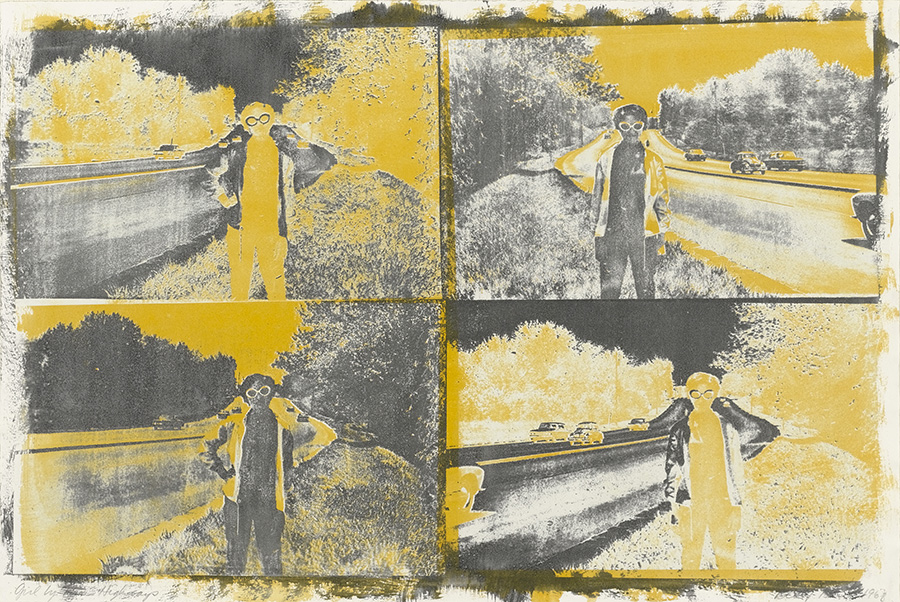William Green
Looking Backward & Looking Forward: Process Photography in the United States, c. 1970
My dissertation project, “Looking Backward & Looking Forward: Process Photography in the United States, c. 1970,” explores American photography from the 1960s and 1970s through the critical lens of process. By process, I refer specifically to the material and chemical steps involved in the creation of a photographic object. My research focuses on photographs that were made primarily in the darkroom. I call these objects process photographs, a term of my own creation, which I use partly to maintain brevity, and partly because existing terms, such as “alternative process” or “experimental” photography, fail to capture the incredible range of approaches that flourished in the United States in the years around 1970.

Thomas Barrow, Tucson Palm, 1974–1978, gelatin silver print, Gift of George and Alexandra Stephanopoulos, 2003.148.5
For several decades prior, art photography was virtually synonymous with “straight” photography, an aesthetic doctrine that severely restricted what a photographer could do in the darkroom on the basis of maintaining medium-specific purity. Yet, amid the social upheavals of the ’60s, young photographers began to question such modernist beliefs. Some looked back to the medium’s unruly 19th-century past, reviving long-extinct processes, such as the cyanotype, that predated the industrial standardization of photographic materials. Others experimented with new imaging technologies, tinkering with their mechanical systems and exploring their untapped potential to create art. The emergence of process photography signaled a rejection of “straight” photography and any theory that would essentialize the medium to a single set of materials and formal characteristics.
My dissertation explores process photography through the themes of alchemy, interruption, weaving, and aftereffects. Chapter 1 takes the first of these as its concern. Long associated with magic and the occult, alchemy is a transformative process through which different elements are synthesized to yield a new object. Jerry N. Uelsmann (1934–2022) famously drew upon the term to describe his own darkroom practice, which involved combination printing several negatives into dreamlike composites—for example, in Untitled (1964). Other process photographers practiced solarization, altered their photographic chemistry to stain their prints, and employed other transformative effects. The photographs explored in this chapter tend to invite highly personal interpretations, which I connect to Carl Jung’s conception of psychological alchemy and the spiritual esotericism of ’60s counterculture.

Betty Hahn, Girl by Four Highways, 1968, hand-applied emulsion photograph, The Museum of Modern Art, New York, Purchase, 73.1970. © 2024 Betty Hahn. Photo: © The Museum of Modern Art / Licensed by SCALA / Art Resource, NY
Chapter 2 explores process photography through the theme of interruption. It focuses on photographers who physically interrupted the photographic process, yielding images that disrupt the medium’s window-onto-the-world illusionism and the passive viewing habits we typically bring to photographs. Thomas Barrow (b. 1938) interrupted the photographic process in his series Cancellations, in which he carved X’s into his photographic negatives before printing them in the darkroom. The resulting photographs pose a perceptual challenge to the viewer, whose attention is divided between the image content and the mangled image plane. In this chapter, I consider the photographic process as a complex system that can be tampered with and interrupted. These interruptions amount to glitches that ran counter to the supposedly infallible and rational technologies of the Cold War.
The theme of Chapter 3 is weaving. It explores the work of process photographers who incorporated manual techniques, such as sewing and liquid emulsions, into their processes, thereby drawing attention to the hand, rather than the eye, of the photographer. Their photographs upset gendered distinctions between art and craft, as well as the boundaries between photography and adjacent media. Betty Hahn (b. 1940) used gum bichromate, a hand-applied emulsion process, to make unconventional photographs such as Girl by Four Highways (1968), which looks more like the pop art of Andy Warhol (1928–1987) than traditional art photography. In this chapter, I use weaving as a metaphor to explain the media hybridization of art photography, arguing that process photographers wove outside technologies, techniques, and voices into the discursive fabric of photography.
The fourth and final chapter is organized around the theme of aftereffects. It focuses on techniques, such as the overpainting and hand-tinting of Ricardo Valverde (1946–1998)—as seen in Loteria de Muertos (1983, printed 1993)—that occur after the initial photographic process has been completed. These aftereffects complicate our understanding of the photograph as a stable object and container of memory. I also use the aftereffect theme to explore the legacy of process photography, which fell out of critical favor in the early 1980s. The chapter closes with a short postscript discussion of 21st-century photographers whose works echo the central themes of my dissertation.
During the fall semester of my Center fellowship, I undertook an intensive period of writing, conducted several long-form interviews, and went on a short research trip. In the spring semester, I submitted, revised, and successfully defended my dissertation.
Rutgers, The State University of New Jersey
Twelve-Month Chester Dale Fellow, 2023–2024
After graduating from Rutgers University this spring, William Green will continue his research and begin developing “Looking Backward & Looking Forward: Process Photography in the United States, c. 1970” into an exhibition proposal.
